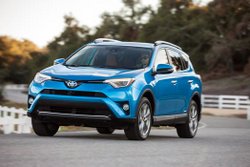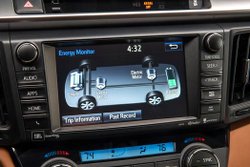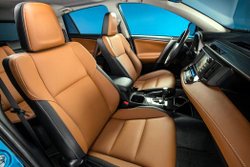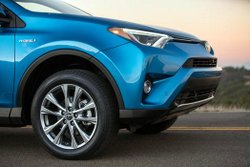A Dash of Extra Efficiency

When the Toyota RAV4 debuted 20 years ago, it was at the forefront of what has become a huge market segment today—compact SUVs. Popularly known today as “crossovers,” they blend a higher-riding, truck-like configuration with an automobile chassis.
With its pinched nose and other tweaks, the 2016 model resembles its fellow Toyotas. As a sibling of the Prius, it now comes as a hybrid model.
Choose from three trim levels—XLE, SE, and Limited—and with the hybrid you get a long list of modern car features with significantly improved fuel economy and green cred.
The Numbers Game
How much better? Comparing all-wheel-drive (AWD) versions, the hybrid earns EPA fuel economy numbers of 34 City, 31 Highway, and 33 Combined. The gas-only model gets 22 City, 28 Highway, and 25 Combined. The Hybrid’s combined rating is 32 percent better, with most of the improvement coming during city driving.
The RAV4, like all hybrids, generally uses its electric motor more in slower, in-town driving. Regenerative braking, which hybrids use to recharge their batteries, happens much more often on city streets. My week of testing, much of it in freeway commuting with some local driving, delivered 31.3 mpg.
Smog and Greenhouse Gas Scores

The EPA Green Scores for the2016 Toyota RAV4 Hybrid are 7 for Smog and 8 for Greenhouse Gas—much better numbers than most cars other than pure electrics and dedicated hybrids like the Prius. The last Prius I tested got the same 7 for Smog but a perfect 10 for Greenhouse Gas, so it’s still the king. Of course, the 3,050-pound Prius uses a 1.8-liter four-cylinder gas engine while the 3,950-pound RAV4 Hybrid has a 2.5-liter one, so you’d expect that difference.
The RAV4 Hybrid blends a 150-horsepower, 2.5-liter four-cylinder engine with an electric motor for a combined 194 horsepower. The gas version is powered by a 2.5-liter four-cylinder engine that puts out 176 horsepower. The Hybrid is good for a decent 8.1-second 0-60 acceleration time.
Doing Many Things Well
Part of why small crossovers are so popular is that they do so many things well. They’re not too big for maneuvering around crowded city streets, but can calmly cruise on the freeway all day. Their rear hatch and high roof shape give you plenty of hauling capacity. My Electric Storm Blue tester boasted 35.6 cubic feet of storage with the second-row seat up and double that (70.6 cubic feet) with that seat folded.
The RAV4, aiming to look rugged, flaunts a busy, edgy dash. There’s a two-level storage bin and a sliding armrest. My tester’s terra cotta accents on the doors, dash, and seats helped relieve the overall black plastic feel.
The Limited Fashion

As a Limited, my car featured Softex (fake leather) seating with heating and memory settings (without a trace of that luxury leather smell, sadly). Extra sound insulation kept it peaceful in there, too. The Entune Premium Audio system, upgraded in the Limited, uses a seven-inch screen with music, apps, navigation, phone interface, and everything else you expect now.
Part of owning a hybrid is learning to drive more efficiently. You can watch a colorful display of your energy flow on the dash center screen, but the small, simple display right in the center of the instrument panel tells the same story. It shows a wheel and an engine, with a battery below. Lines between then indicate if you were using electricity or generating it, and if the engine was engaged or not. Of course, you can monitor your fuel economy numbers anytime.
Toyota Safety Sense
The company is proud of its Toyota Safety Sense technology, which now incorporates pedestrian detection (so it’s called TSS-P, which is the reverse of a 1960s spray-on shampoo). You get pre-collision warnings, lane departure alert with steering assist, automatic high beams, and dynamic radar cruise control. What this all adds up to is, the car knows what’s going on and will help you avoid hitting pedestrians, keep your car in the lane and maintain a safe distance when using cruise control. What’s not to like?
Only a Little Bump

Hybrids cost more than regular gas burners. How much? The cheapest non-hybrid RAV4, an LE with two-wheel drive, starts at $24,910. But for a real comparison, the Limited AWD gas version retails at $33,230. The Hybrid Limited AWD, like mine, runs $34,030. That’s only an $800-dollar difference, and that dollar difference applies at all three trim levels.
The SE version of the Hybrid gives you a sport-tuned suspension and some styling differences, and costs $32,185, while the Hybrid XLE is the gas/electric entry point, at $29,030. Add $900 to every one of those prices for destination charges.
There’s a movement toward subcompact crossovers for even more efficiency and cuteness, but for now, the 2016 Toyota RAV4 Hybrid compact SUV is in the driver’s seat. The hybrid model, for not much more cash, is a responsible choice.
Related Stories You Might Enjoy:
Road Test: 2016 Mazda CX-5
Road Test: 2017 Kia Sportage
Garage Mate for Your Ev: 2016 Mazda CX-5
Road Test: 2016 Nissan Rogue
Road Test: 2016 Ford Escape
Top 10 Best MPG AWD SUVs/Crossovers
Road Test: 2015 Toyota RAV4
Road Test: 2015 Honda CR-V
Road Test: 2015 Mitsubishi Outlander Sport
Disclosure:
Clean Fleet Report is loaned free test vehicles from automakers to evaluate, typically for a week at a time. Our road tests are based on this one-week drive of a new vehicle. Because of this we don’t address issues such as long-term reliability or total cost of ownership. In addition we are often invited to manufacturer events highlighting new vehicles or technology. As part of these events we may be offered free transportation, lodging or meals. We do our best to present our unvarnished evaluations of vehicles and news irrespective of these inducements.
Our focus is on vehicles that offer the best fuel economy in their class. We also feature those that are among the top mpg vehicles in their class. In addition, we aim to offer reviews and news on advanced technology and the alternative fuel vehicle market. We welcome any feedback from vehicle owners and are dedicated to providing a forum for alternative viewpoints. Please let us know your views at publisher@cleanfleetreport.com.

14 thoughts on “Road Test: 2016 Toyota RAV4 Hybrid”